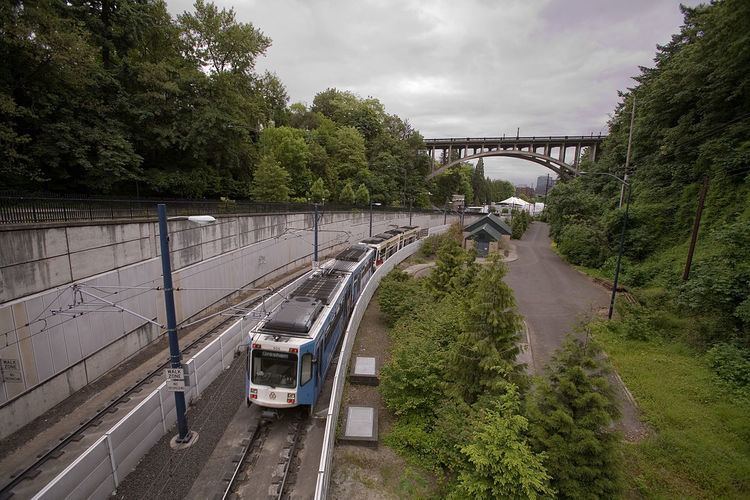Website MAX Blue Line Electrification overhead catenary Stations 51 Locale Portland | Opened September 5, 1986 Line length 52,626 m | |
 | ||
Track gauge 1,435 mm (4 ft 8 ⁄2 in) standard gauge Terminis Cleveland Avenue MAX Station, Hatfield Government Center MAX Station | ||
The MAX Blue Line is a 33-mile (53 km) light rail line in the MAX Light Rail system in the Portland metropolitan area in the U.S. state of Oregon. Operated by TriMet, the line runs between Hillsboro and Gresham, via downtown Portland. It is the longest line in the MAX system and the trunk route of the system. The line carried an average of 65,200 riders per day (boardings) on weekdays during TriMet's Fiscal Year 2011 (July 2010–June 2011).
Contents
Eastside MAX
This 15-mile (24 km) line, running from downtown Portland east to Gresham, was the first line to be opened in the MAX system. Construction began in 1982, and service was inaugurated on September 5, 1986. For more on the early history of this line, see MAX light rail.
As of September 2006, TriMet said the Eastside MAX has spawned over $4.7 billion in development and redevelopment "within walking distance" of its route.
The Eastside line originally had 24 stations in each direction. However, two new stations—one eastbound and one westbound—were opened in March 1990 at the then-new Pioneer Place mall, in downtown, three days before the retail complex opened to shoppers. Later the same year, in September 1990, a new bi-directional station was opened at the Oregon Convention Center, shortly before the center's opening. These two stations brought the total (in each direction) up to 26.
As originally constructed, the 2-mile section of the MAX line between Ruby Junction/East 197th Avenue and Cleveland Avenue stations was mostly single-track. Trains operating in both directions had to share one track, with signaling keeping them separate. This reduced construction costs, but limited operational and scheduling flexibility and sometimes delayed trains. During a multimonth project in 1996, a second track was laid along that section, giving the Portland–Gresham line two tracks over its full length. The MAX Path, a paved trail running along the MAX line for this same stretch of track, is under construction by the city of Gresham. It will connect the Gresham–Fairview Trail to downtown Gresham.
Eastside MAX became connected to the Westside Line from the opening of the latter in 1998, making one 33-mile line. Only a few rush-hour trips from Gresham continued to terminate in the city center and not serve the new Westside extension. However, not until 2000 did TriMet decide to use colors to distinguish its separate light rail lines for riders, and these came into use in 2001. The east-west, Gresham–Downtown–Hillsboro line then became designated as the Blue Line, or (in later marketing) MAX Blue Line.
In November 2007, a 71-year-old man was beaten with a baseball bat by a 15-year-old suspected gang member at a Gresham MAX Station. This incident, and several others, prompted local officials to express concern about crime along the MAX, and to step up police patrols along the line.
Beginning in January 2015, stations on the original Blue Line alignment between Hollywood/NE 42nd Avenue and Cleveland Avenue received upgrades to add lighting, improve shelters, and construct infrastructure for future e-fare and information display systems. Trees on the platforms were also removed to increase line-of-sight for security cameras. In conjunction, pedestrian crossings of the MAX tracks in Gresham were realigned to improve safety.
Westside MAX
In 1990, Portland area voters approved funding for the Westside MAX line after the success of the Eastside MAX. It was originally conceived as a line between downtown Portland and 185th Avenue in Hillsboro, but was later in the planning process extended to downtown Hillsboro. Much of the right-of-way used in Beaverton and Hillsboro reused a route first constructed for the Oregon Electric Railway.
Construction started in 1993, at the site of the east end of the future West Hills tunnel (renamed the Robertson Tunnel in 1998). A half-mile extension between Southwest 10th Avenue and Kings Hill (Southwest 18th Avenue at Southwest Salmon Street) opened in August 1997. This extension was going to include the rest of the originally-planned segment, but was delayed by tunneling problems. Instead, it was opened along with the section from Beaverton to downtown Hillsboro in September 1998. The “golden spike” of the Westside line was driven with the final section of track of the project installed on the Main Street Bridge in October 1997. Passenger service on the $964 million project began on September 12, 1998.
The line drew strong ridership, and beat 2005 ridership projections less than two years after the line opened. As of 2004, the Westside MAX has served as a magnet for $825 million worth of residential and commercial development, including 8,500 housing units launched within walking distance of the line.
